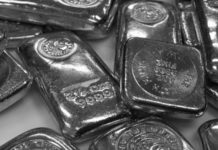
[miningmx.com] — EXCITING times have returned to the platinum sector, which is good news both for investors and for ‘South Africa Inc’, which dominates world supply of the metal.
The reasons for the optimism are the sharp recovery in the platinum price over the past 12 months and expectations that strength will be maintained. Prospects for sister platinum group metal (PGM) palladium look even brighter.
Impala Platinum (Implats) marketing executive Derek Engelbrecht said the palladium price could double over the next five years from the current level of around $430/oz. South Africa is the world’s second largest producer of palladium after Russia, so South African mines will also reap extra benefits from that should he be proved right.
Platinum has recovered from a low of $756/oz in December 2008 to currently trade above $1,500/oz, which is the same level the metal stood at early in 2008 ahead of the Eskom crisis, which “spiked’ platinum to nearly $2,300/oz by April that year, said Engelbrecht.
The subsequent plunge to $756/oz caught everybody by surprise, because worst case industry predictions were that the metal would find support at around $1,200/oz.
The plunge and recovery in the price – and the knock-on effect on the share prices of platinum major, junior and exploration companies – have set up the current situation where investors are spoilt for choice in terms of what to buy, depending on their appetite for risk.
ETF adding price volatility
There’s a huge caveat, however: platinum has become a volatile business and the growing involvement of investors through the new exchange-traded funds (ETFs) is going to make it more so. It seems platinum may be trending back to the relationship with gold that ruled during the Eighties before the white metal developed its own identity as growing demand from vehicle manufacturers put a floor under the price.
In a nutshell: when gold goes up, platinum goes up faster; and when gold goes down, platinum goes down faster. The link between the two was highlighted last year by Paul Walker, CEO of British metals consultancy GFMS, when he said: “People who invest in gold also tend to invest in platinum.’
The other factor would-be platinum investors must watch closely is the rand. The rand’s strength has robbed South Africa’s platinum producers of much of the revenue benefit from the recovery in the dollar PGM prices over the past year.
Major movements in the rand, such as sharp swings in investment sentiment through the ETFs, can push platinum and equity prices dramatically in either direction.
A sharp weakening of the rand or a surge in investment buying could spike the platinum price, along with share price levels. A strong rand or a simultaneous decision by ETF investors to “head for the exits’ could put platinum through the floorboards.
A look at the platinum price graph since January 2008 proves the point. There’s an obvious conclusion: these are shares that you need to trade.
Platinum stocks worth buying
So keeping all that in mind let’s take a look at what’s available on the platinum equity menu.
Aquarius Platinum CEO Stuart Murray once famously described the platinum business as consisting of “three 600 pound gorillas and a whole lot of rats and mice, of which we like to think of Aquarius as King Rat’.
Starting with the gorillas – Anglo Platinum (Angloplat), Impala Platinum (Implats) and Lonmin – the story here is one of recovery from the production problems that have plagued all three. The latest round of results shows Implats has way outperformed the other two in terms of profitability, cost control, getting production back on track and maintaining a sound balance sheet.
Implats has kept paying dividends while both Angloplat and Lonmin passed them during their respective 2009 financial years. Angloplat is holding a R12.5bn rights offer at a deep discount to reduce its debt burden.
Implats CEO David Brown rubbed it in when he commented: “We think we’re undervalued relative to Angloplat and Lonmin. We believe Implats remains the premier investment in the platinum space.’
Despite that, JP Morgan analysts Steve Shepherd and Allan Cooke reckon Angloplat and Lonmin are better investments. They’re “neutral’ on Implats’ operations, citing perceived higher operating risk exposure over the next two years.
They comment: “We continue to recommend major exposure to the sector through Angloplat and Lonmin. Since we’re positive about the outlook for PGMs we advocate an aggressive equities exposure.’
Turning to the rats and mice, the two themes for investors here are “survival’ and “consolidation’. The juniors went through hell last year when the platinum markets collapsed because they didn’t have the balance sheets of Lonmin or Implats to fall back on, nor a big brother such as Anglo American to prop them up.
Those that coped – notably, mid-tier producers Northam Platinum and Aquarius and juniors such as Eastern Platinum (Eastplats), Platmin and Anooraq – now merit close attention.
Throw in the strong possibility of further industry consolidation and you have the reason why the Eastplats share price has almost quadrupled over the past year to more than 900c.
Investors who are really feeling bullish might like to recall the all-time high for Eastplats in 2008 – before the roof fell in – was north of R30 per share. There is, as they say, considerable upside potential.
Eastplats is marked as a potential takeover candidate due to its strategic position between Lonmin and Xstrata’s Eland Platinum operation west of Brits. Some observers reckon Xstrata – which still holds 24,9% of Lonmin after its previous failed bid – may be considering another run at Lonmin.
Northam
Then there’s Northam, which controls Booysensdal – arguably the best undeveloped platinum property left in South Africa. Implats had a go at Northam in 2008 but eventually walked away.
Speculation is Kazakh resources giant ENRC was taking a close look at Mvelaphanda Resources – which controls Northam – at year-end 2009.
“King Rat’ Murray has made no secret of his desire for Booysensdal. He took over Ridge Mining last year and is cash-flush following a highly successful convertible bond issue.
Another possible target is Wesizwe Platinum, where it was revealed that offers were made late last year by both Implats and Chinese gold miner Jinchuang.
And if you really feel like rolling the die, there are two juniors offering potentially spectacular returns if they get it right but, of course, correspondingly high levels of risk. Those are Bernard Swanepoel’s Village Main and Dennis Tucker’s Absolute Holdings.
Both are going for potential new, deep-level mines on the Eastern Limb of the platinum-bearing Bushveld Complex that would require major capital investments.
Village is further down the track than Absolute because the Lesego Platinum project it’s bought has already been drilled and has an “inferred’ resource. Lesego was supposed to list on the JSE last year but that was pulled because of the global financial crisis.
Absolute’s project hasn’t yet been drilled and it only has a “reconnaissance’ resource at this stage.
Village has motored from a 12-month low of 23c to a high of 360c since Swanepoel became involved in the company – a lot of that coming since the platinum play was announced.
Ryan holds shares in Impala Platinum, Aquarius Platinum and Wesizwe Platinum.









